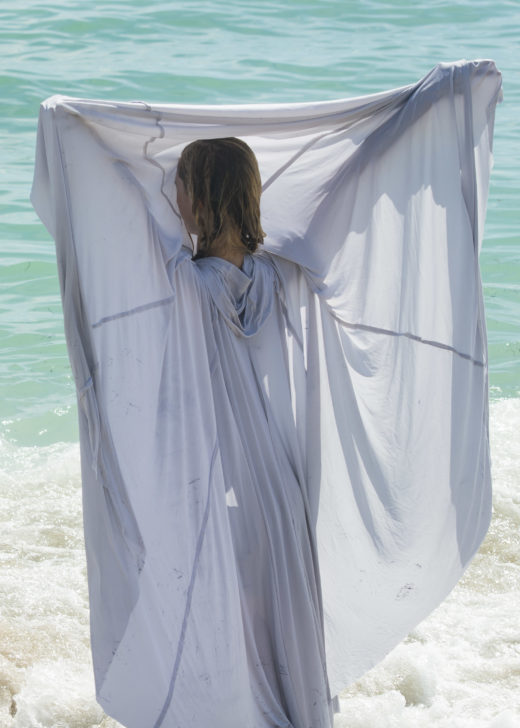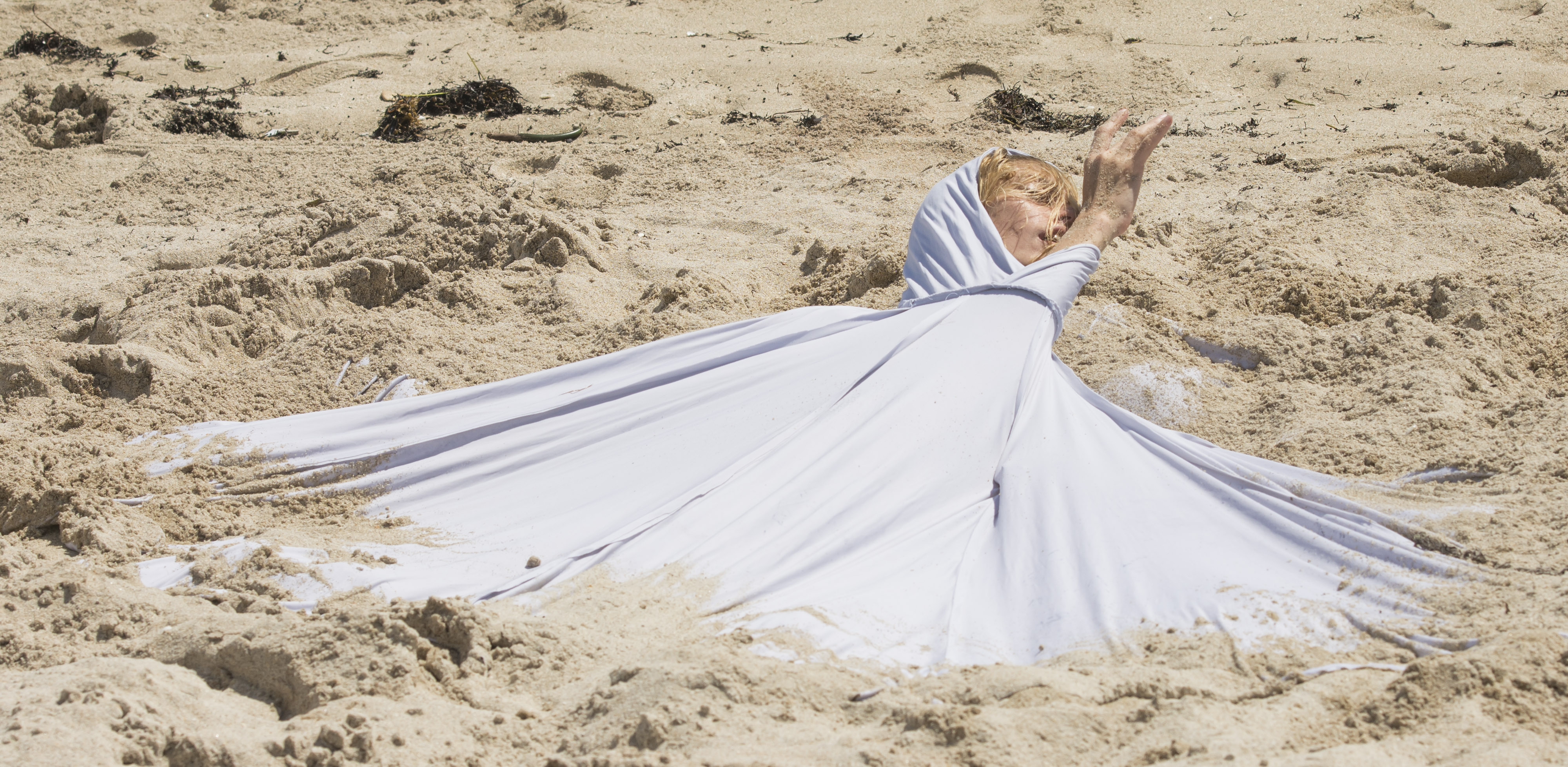- Miami’s Silent Film Industry, 1910-1926

- EPICS UNFOLDING IN OUR BLOOD: Third Horizon Caribbean Film Festival
Marissa Alma Nick’s Mira el Mar
Catherine Annie Hollingsworth
 Performer Juliana Triviño in Mira El Mar. All photos credited to Mitchell Zachs.
Performer Juliana Triviño in Mira El Mar. All photos credited to Mitchell Zachs.
Surfside Beach, Miami, FL
October 17-18, 2016
Some dance compositions progress with a narrative arc like a story; others hit you indescribably, like a poem. Most gain their punctuation from changes over time. Choreographer Marissa Alma Nick’s recent project Mira el Mar is more of a spatial encounter, like a sculpture. It is not about dynamics, emotions, or even movement. It is about place.
Set on the beach, Mira el Mar imagined Miami 75 years in the future, when climate change has fundamentally transformed living conditions in South Florida. In this reality, Miami has become an aquatic place. Most people have fled, but a few have chosen to remain and adapt to the new environment.
Although the idea of Mira el Mar felt sci-fi in tone, the performance site was only minimally altered. A space was demarcated by four construction cones and two large holes were dug into the sand. The waterline was swollen with the influence of a full moon and a king tide, a phenomenon that causes flooding farther down the coastline in South Beach.
In Mira el Mar’s opening image, the heads of two possibly human characters poked out of the holes in the sand, surrounded by some kind of white stretchy material. An amorphous black object floated on the water in the background. Over the course of twenty minutes, the figures slowly stretched and contorted their way out of the sand and toward the water in monotone movement. No music. The black object remained floating offshore. Once the two figures landed in the water, the performance came to a close. It brought to mind the history of evolution in reverse—instead of crawling out of the water, humans devolve into animals and crawl back in.
In its minimalism, Nick’s choreography left one wondering when the show was really going to begin—and then it was over. It was like an encounter with an object or an idea. Dynamics came not from shifts in the piece itself, but from the process of getting to the performance location, being there, experiencing the space and the sound of the site, and imagining the reality suggested by the performers’ appearance and way they moved their bodies. It was a meditative immersion in one of many possible futures.

Nick chose a well-populated beach in Miami’s Surfside neighborhood a few blocks away from where she grew up. The area is one she is intimately familiar with, and she has seen it change over time. She reports that a few blocks south, where she had originally intended to stage her piece, eroding sand gets replaced regularly in an effort to keep the waterline from creeping closer. And she has seen the zoning in Surfside change a town of small buildings into fresh land for new high-rise developments. On the way to the performance, it would be impossible to miss the new constructions along Collins Avenue. There sits the massive and unfinished Surf Club, glass covered in blue, protective film like a brand-new toy. Nearby, the Fendi Chateau Residences are in progress on the former site of a humble Best Western.
Nick’s perspective on climate change as represented in Mira el Mar is optimistic; instead of fighting to halt climate change, she takes it as inevitable and asks how we would adapt. The costume-props designed by Nick’s collaborator Sebastian Ruiz suggested changes in form, habitat, and behavior. The primary figures’ white garments, wrapped around their heads and surrounding their bodies, could have been high-tech protective gear or a creature’s skin armor. The black floating object might have been a person, a watercraft, an instrument, or a piece of trash. The composition provokes us to imagine this very same site in a vastly different reality. Would the glossy condos still be there in 75 years?
Mira el Mar was the first of four performances to come out of Grass Stains, Pioneer Winter Collective’s mentorship project. Over the past year, five artists have been given financial support and artistic mentorship to develop new site-specific work. Under the guidance of LA-based site choreographer Stephan Koplowitz, the artists chosen for Grass Stains were coached in deep engagement with location. From Koplowitz’s perspective, site-specific is a distinct type of work and method of creation. Compositions are not simply transplanted from the studio into an outdoor backdrop, but are integrally informed by, and in dialogue with, the site itself.
Grass Stains artists were encouraged to choose sites whose context could become a part of the work. They were also guided through the practicalities that come with site-specific work, from audience safety to weather conditions and changing terrain. Nick’s project responds to the physicality of sand and water, and it draws meaning not just from the small piece of land defined by four cones but from the surrounding setting—she could have exploited the potential of the site even further. This work could only exist on the beach.
Catherine Annie Hollingsworth is a Miami-based dance and performance writer.









